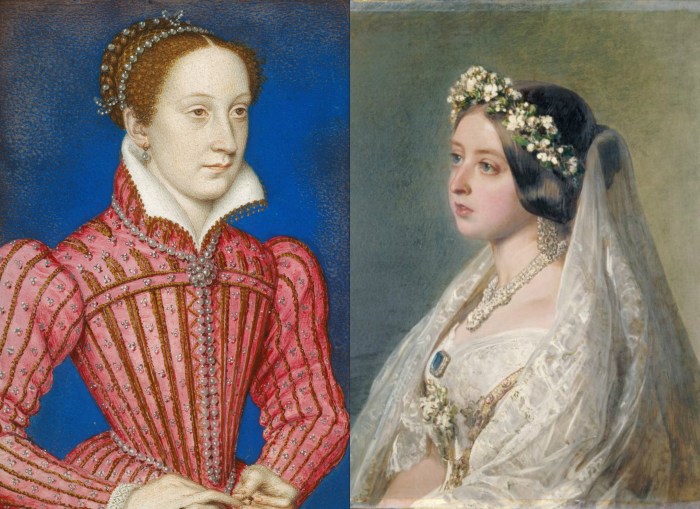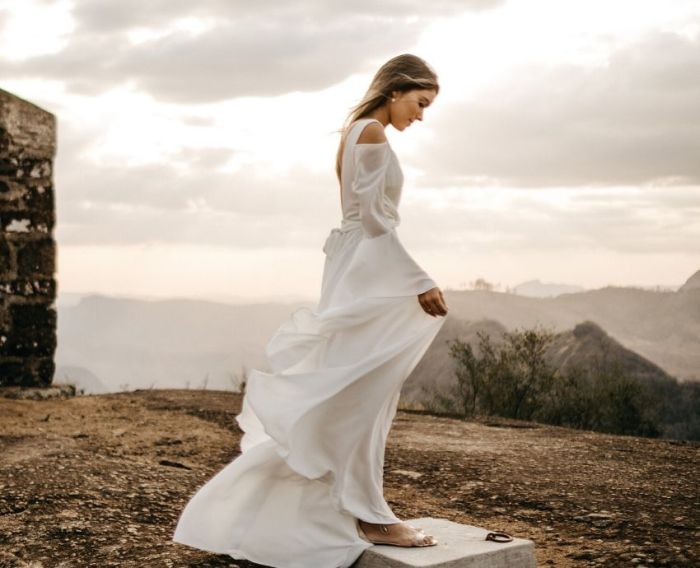The Enduring Allure of the White Wedding Dress: Origins Of White Wedding Dress
Origins of white wedding dress – The pristine white wedding gown, a seemingly timeless symbol of bridal purity, is a surprisingly recent invention. Its dominance in Western wedding traditions is a captivating narrative woven from threads of royal influence, evolving cultural interpretations, socioeconomic shifts, and the powerful lens of popular culture. This exploration delves into the origins and evolution of the white wedding dress, unraveling the complex tapestry that has shaped its enduring appeal.
Queen Victoria’s Enduring Legacy
Queen Victoria’s 1840 wedding to Prince Albert irrevocably altered the course of bridal fashion. Her choice to wear a white gown, a departure from the then-prevalent practice of wearing richly colored dresses, was a bold statement that resonated far beyond the confines of the royal court. The gown itself, crafted from Honiton lace, a delicate and expensive fabric, featured a high neckline, long sleeves, and a full skirt, establishing a template for future bridal styles.
This marked a decisive shift away from the opulent, richly colored silks and velvets favored by previous generations of brides, who often wore their best dresses, regardless of color.
| Feature | Pre-Victorian Wedding Attire | Post-Victorian Wedding Attire |
|---|---|---|
| Color | Varied; often vibrant colors like red, blue, or green reflecting wealth and status. | Predominantly white, symbolizing purity and innocence. |
| Fabric | Silk, velvet, brocade – luxurious materials signifying affluence. | Lace, satin, and other fine fabrics, although accessibility varied across socioeconomic classes. |
| Silhouette | Varied depending on fashion trends; often emphasized a woman’s figure. | Initially full-skirted, evolving over time to reflect changing fashion trends. |
| Embellishments | Elaborate embroidery, jewels, and other opulent details. | Lace, beading, and other embellishments, again varying with affordability. |
Religious and Cultural Symbolism of White
The association of white with purity and virginity is deeply rooted in various religious and cultural contexts. In Western cultures, particularly within Christian traditions, white has long been associated with innocence and spiritual purity. However, this symbolism isn’t universally consistent. The meaning and significance of white in wedding attire have evolved over time and differ across various religious and cultural traditions.
- In some Eastern cultures, white is associated with mourning, making it an unsuitable color for weddings.
- Historically, many brides wore their finest dress, regardless of color, reflecting their family’s wealth and status.
- Red, symbolizing good fortune and prosperity, has been a popular wedding color in numerous cultures.
Socioeconomic Influences on Bridal Attire
The widespread adoption of the white wedding dress wasn’t solely driven by royal influence; socioeconomic factors played a crucial role. The cost and availability of white fabrics, initially a luxury, directly impacted the accessibility of the white wedding dress across different socioeconomic classes. The increasing industrial production of white fabrics like cotton and later, synthetic materials, made white wedding dresses more affordable over time.
A hypothetical timeline illustrating the changing affordability of white wedding dresses might look like this:
- 1840-1880: Primarily a luxury, affordable only to the wealthy elite.
- 1880-1920: Increasing accessibility due to mass production of cotton and improved dyeing techniques.
- 1920-Present: Wide availability across socioeconomic classes, with variations in fabric quality and embellishments reflecting affordability.
The Evolution of Wedding Dress Styles
The white wedding dress hasn’t remained static. Its evolution mirrors broader societal changes and evolving fashion trends. From the full-skirted Victorian gowns to the sleek, minimalist styles of the 1920s and the voluminous silhouettes of the 1950s, each era has imprinted its distinct aesthetic on the bridal landscape.
| Era | Style | Fabric | Silhouette |
|---|---|---|---|
| Victorian (1840-1900) | Full-skirted, high-necked gowns often featuring lace and embellishments. | Lace, satin, silk | Full, voluminous skirts; fitted bodice. |
| Edwardian (1900-1910) | More streamlined silhouettes, often with long sleeves and high necklines. | Silk, lace, satin | S-bend silhouette; fitted bodice, full skirt. |
| 1920s | Dropped waistlines, shorter hemlines, and simpler designs. | Silk, crepe, beaded fabrics | Straight, loose silhouette; dropped waistline. |
| 1950s | Full skirts, cinched waists, and often featuring lace or embroidery. | Satin, lace, tulle | Full, A-line or ballgown silhouette; fitted bodice. |
The White Wedding Dress in Popular Culture, Origins of white wedding dress

Source: azazie.com
The white wedding dress has been a powerful symbol in literature, film, and other media, often used to convey themes of romance, purity, and societal expectations. These portrayals have significantly shaped perceptions and expectations surrounding weddings and bridal attire.
- Pride and Prejudice features elegant gowns reflecting the social standing of the characters.
- Classic Hollywood films often depicted elaborate, romanticized wedding dresses, influencing bridal trends.
- Modern media showcases a wider range of wedding styles and challenges traditional notions of bridal attire.
Modern Interpretations and Trends

Source: affino.com
Contemporary wedding dresses demonstrate a departure from rigid traditions. Designers are pushing boundaries, incorporating diverse fabrics, silhouettes, and embellishments. The modern bride has a wider array of choices, reflecting her individuality and personal style.
- Two-piece gowns offer a modern twist on traditional designs.
- Colored accents and unconventional fabrics challenge the traditional all-white aesthetic.
- Bohemian styles emphasize flowy fabrics and relaxed silhouettes.
A hypothetical modern wedding dress might feature a sleek, asymmetrical silhouette crafted from sustainable silk, accented with delicate hand-embroidered details and incorporating unexpected pops of color, challenging the rigid tradition of an all-white gown while still retaining an element of timeless elegance.
So, Queen Victoria made white the wedding dress thing, right? Before that, brides wore whatever color they had. But now? It’s all about that perfect silhouette, and sometimes you need a little help achieving it, which is where checking out options like spanx for wedding dress comes in handy. Ultimately though, the tradition of a white dress still reigns supreme, even if we use modern tricks to get the look just right.
FAQ Compilation
What are some common misconceptions about the history of the white wedding dress?
One common misconception is that white has
-always* symbolized purity and virginity in wedding attire. In reality, the association is relatively recent and culturally specific.
How has the design of the white wedding dress changed over time?
Styles have dramatically shifted, from the voluminous gowns of the Victorian era to the more streamlined silhouettes of the 1920s and the diverse range of styles seen today. Fabrics, embellishments, and overall aesthetics have also undergone significant transformations.
Are there any notable examples of non-white wedding dresses in history?
Absolutely! Historically, brides wore a variety of colours depending on their cultural background and socioeconomic status. Rich colours like red, blue, and even green were popular choices in many cultures.
How has the cost of materials influenced the prevalence of white wedding dresses?
Initially, white was a luxury due to the cost of producing and maintaining white fabrics. As production methods improved and white became more accessible, its use in wedding dresses increased across different socioeconomic groups.
